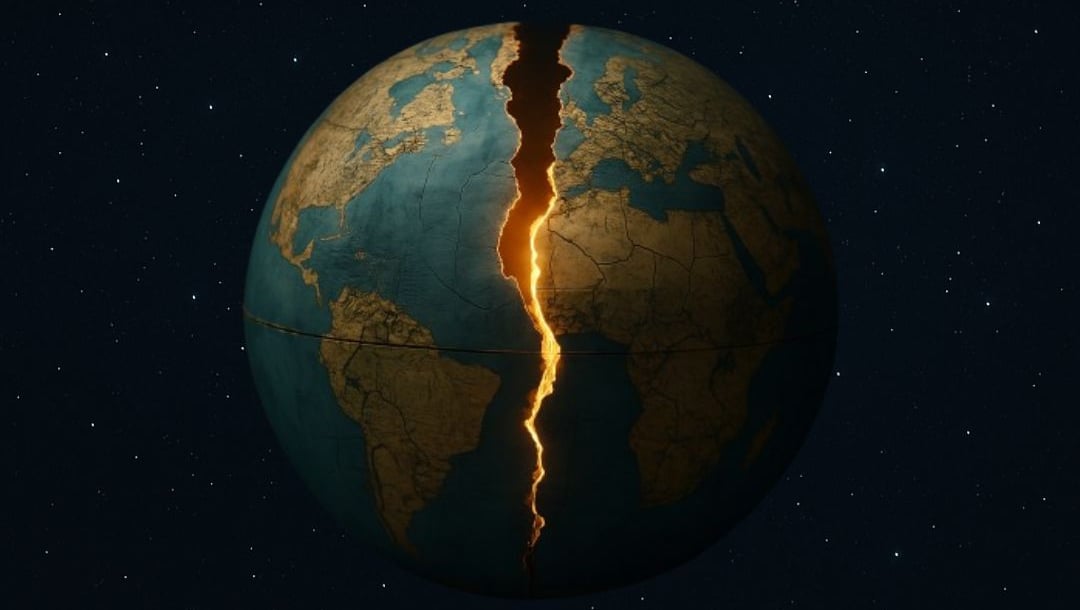Strategizing from 6 cities across the globe
Is the Cycle of Shifting World Order Dismantling?
As societies began to expand and interact through trade, conquest, and diplomacy, the concept of the world order emerged, defined as an international system of preferred arrangements aiming to encourage and promote global stability. However, history has proven time and time again that there is no such thing as an enduring state of peace and rather that stability is found only in fleeting equilibrium—tactical and short-lived.
CONSPIRACYLAWCIVIL SOCIETYDEMOCRACYPOLITICSINTERNATIONAL LAW
Uma Terpend
3/27/20256 min read


What is the World Order?
From the earliest negotiations amongst ancient tribes to the intricate diplomatic frameworks structuring the modern era, human civilization has continually sought order amid chaos in the state of nature. As societies began to expand and interact through trade, conquest, and diplomacy, the concept of the world order emerged, defined as an international system of preferred arrangements aiming to encourage and promote global stability. However, history has proven time and time again that there is no such thing as an enduring state of peace and rather that stability is found only in fleeting equilibrium—tactical and short-lived.
In 1815, the Congress of Vienna launched a new era of cooperation and relative peace between European powers—the Concert of Europe. Because of Europe’s dominance in global affairs during the 19th century, this system was highly influential to the international world order until the beginning of World War I. From this point up until World War II, victorious Allied powers implemented treaties, disarmament efforts, and international organizations such as the League of Nations around the idea of preventing another global war, shifting the global order to one of collective security and diplomatic cooperation. Woodrow Wilson’s Fourteen points were crucial in defining the core principles of modern international relations, emphasizing open diplomacy, free trade, international governance, and establishing the League of Nations, the first permanent international organization focused on diplomacy and international security (The National WWI Museum and Memorial, n.d.). During World War II, devastating wartime destruction dismantled European dominance. In the past, shifts of global order have had the cyclical tendency to follow periods of war. Naturally, following World War II, the world order was reborn into a tense, bipolar competition for hegemony between the superpowers of the United States (USA) and the Soviet Union (USSR). Although the fall of the Soviet Union in 1991 marked a significant shift in global power dynamics, the idea of the Liberal World Order strengthened and initiated a transition to a unipolar world order under an American hegemony. There became an international expectation to uphold the pillars of the Liberal World Order exacerbated by the lack of the threat of a significant communist power to impose otherwise. This is not to say that the international order was anywhere near peaceful under this recent establishment—exemplified by conflicts such as the Gulf War, the Yugoslav Wars, and the War on Terror—but rather that the system remained relatively stable under predominantly American leadership.
The Present World Order
“The world is on fire, literally and figuratively.” -G20 Independent Experts Group (2023)
The Liberal World Order can be summarized into three pillars: democracy and rule of law, free market and free trade, and multilateral institutions. The idea of the Liberal World Order was first established in 1914, emerging alongside the conclusion of World War I and consequential diplomatic arrangements that would set groundbreaking precedents for future diplomacy and international governance. Although these first attempts at mitigating international conflict with this new system ultimately failed, the conclusion of World War II saw significant strides towards effective international governance and collective security. Following World War II, multilateral institutions such as the North Atlantic Treaty Organization and the United Nations were founded to enforce international law and peaceful diplomacy. Furthermore, the implementation of the Bretton Woods Agreement by the United States in 1945 laid the economic groundwork for the Liberal World Order. Establishing the World Bank and International Monetary Fund, this agreement aimed to prevent further global conflict and stabilize economies by promoting free trade. However, perhaps the most important component of the Liberal World Order is that of protecting the western principles of democracy, including free elections, rule of law and the protection of civil liberties. Following the Second World War, the West had noticed a pattern of communist ideologies becoming influential in countries facing significant economic turmoil. Consequently, the Marshall Plan was implemented in 1948, rehabilitating economies ravaged by the war with the underlying motive of preventing communist ideologies from spreading. The preservation of democracy would become a fundamental controversy in the following decades, as opponents of the Liberal World order aligned with communist Russia in the clash of ideologies that was the Cold War.
The Liberal World Order that has effectively shaped global governance since the end of the First World War is now beginning to collapse at its foundational level. Although it has largely succeeded in mitigating conflicts in the past century, an era of “increasing warfare and conflict” (Brandon, 2024) inflicts novel pressures onto this increasingly outdated system. Further catalyzing this international political unrest is the significant ideological divide between the East and the West that has not subsided since the end of the Cold War but rather has been placed on hiatus due to the dissolution of the USSR.
With the rapid economic ascent of China as a significant global power, this dormant period effectively has come to an end. History suggests that there are seldom shifts in the world order and the balance of power without violent conflict. The Thucydides Trap, a concept which explores the tendency towards war when an emerging power threatens to displace an existing great power, offers a plausible prediction of the transitionary period into the next established world order. As China asserts itself as the candidate to combat long-standing American hegemony, the question is no longer whether a new world order will emerge, but rather if it will unfold through diplomacy and adaptation or through the conflicts that have historically accompanied shifts in global power.
Challenges to the Liberal World Order
Three modern transformative forces or “revolutions” have profoundly strained and fragmented the current Liberal World Order: globalization, the speed of scientific and technological advancement, and the significant changes within the international balance of power. Increased interconnectedness and globalization have, in recent years, highlighted economic inequalities and raised tensions in the realm of international trade. One way of mapping increasing economic inequality and consequential shifts in global economic power is through a model called the Elephant Curve. This curve is a visual representation of real average national income growth from 1980 to 2008 charted by Christoph Lakner and Branko Milanovic. General observations from this data reflect a steady increase in income growth in the developing world’s middle class and global elites, yet a steady decline for the developed world’s middle class as well as a general lack of growth in the already struggling undeveloped world. This pattern contextualizes a growing distaste for the current Liberal World Order from the declining middle class of the developed world along with the consequent shift of the balance of power to represent the Global South.
Throughout human history, technology and science have played significant roles in global power dynamics, as seen with the ideological influence of the Scientific Revolution and the groundbreaking invention of the printing press. However, nothing has yet to truly parallel the rate at which technological and scientific advancements are improving in the modern era. Technology not only acts as a channel for political discourse both vertically and horizontally but also acts as a means that global powers can employ to consolidate influence. The pursuit for technological development is “a matter of national security and economic strength” for global powers such as the US, EU, and China (Lartey, 2024), and consequently, a possible tool for developing countries to shift the balance of power of the international order in their favor.
The changes within the international balance of power could act as the final blow to the cracking foundation of the Liberal World Order. Callum Fraser from the Royal United States Institute described BRICS, an interstate association of emerging market countries, as “indicative of a collective movement away from the West, a demonstration of a fundamental shift within the world order that is seeking to challenge Western economic hegemony” (Ellyatt, 2024). BRICS leaders have, in the past, expressed the desire for a new world order not centered around Western ideals. An example of this is Russian Head of State Vladimir Putin’s description of the changing world order as “the emerging multipolar world” and expressed that he is “open to discussing the issues of building a new world order” with BRICS allies (TASS, 2024). This rise of alternative economic and political coalitions exemplifies the shift into a multipolar system and ultimately challenges the longstanding dominance of Western institutions.
Even though history has proven time and time again that the world order is mutable and volatile, what cannot be predicted is the way in which the Liberal World Order will transition. As contemporary economic, technological, and geopolitical transformations accelerate, the future of the global landscape lies in how nations choose to evolve their approaches to emerging challenges that lie ahead.
REFERENCES
Brandon, K. (2024, December 11). Transitioning to a new global order. SEI. https://www.sei.org/perspectives/transitioning-to-a-new-global-order/
Ellyatt, H. (2024, October 22). Russia pushes ‘new world order’ agenda as it hosts beefed-up BRICS summit. CNBC. https://www.cnbc.com/2024/10/22/russia-hosts-brics-summit-pushes-new-world-order-agenda-to-rival-west.html
G20 Independent Experts Group. (2023, October 13). The triple agenda: A roadmap for better, bolder and bigger mdbs. Center for Global Development. https://www.cgdev.org/publication/triple-agenda-roadmap-better-bolder-and-bigger-mdbs
Lartey, S. (2024, September). The impact of technology on shaping the world order: the role of global superpowers. Research Gate. https://www.researchgate.net/publication/383704727_The_Impact_of_Technology_on_Shaping_the_World_Order_The_Role_of_Global_Superpowers
TASS Russian News Agency (2024, October 11). Russia ready to discuss building new world order with friends — putin. https://tass.com/politics/1854919
The National WWI Museum and Memorial (n.d.). The fourteen points. https://www.theworldwar.org/learn/peace/fourteen-points
